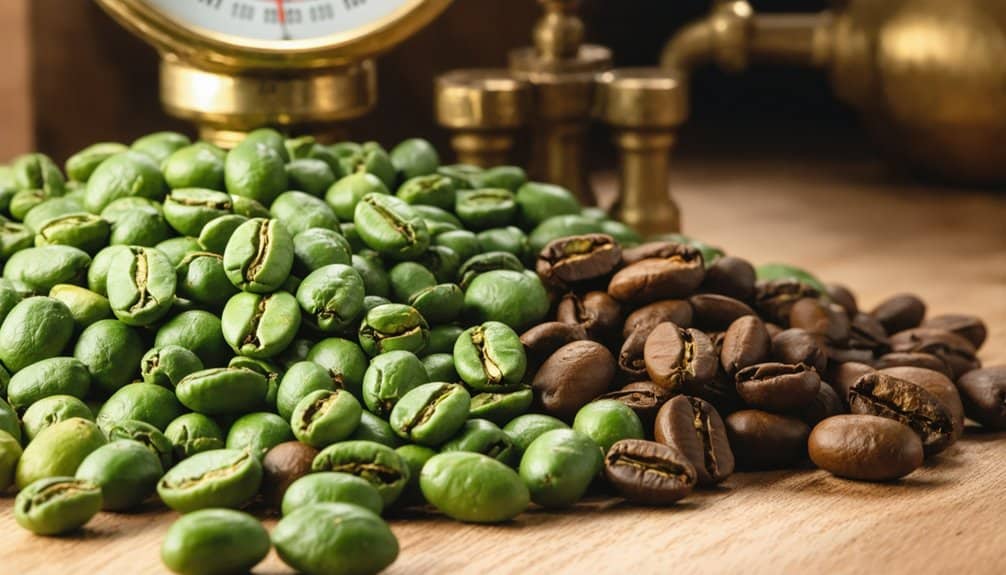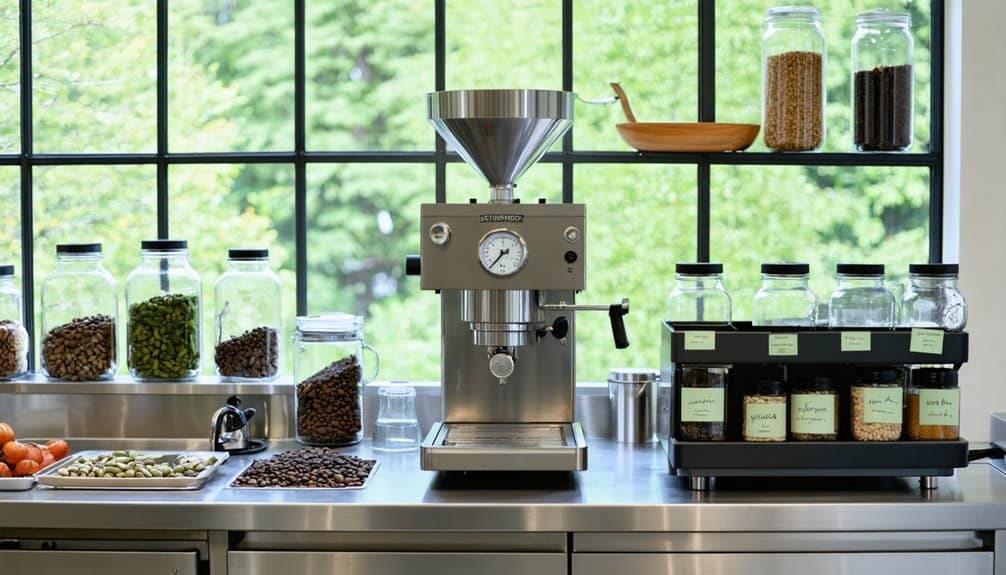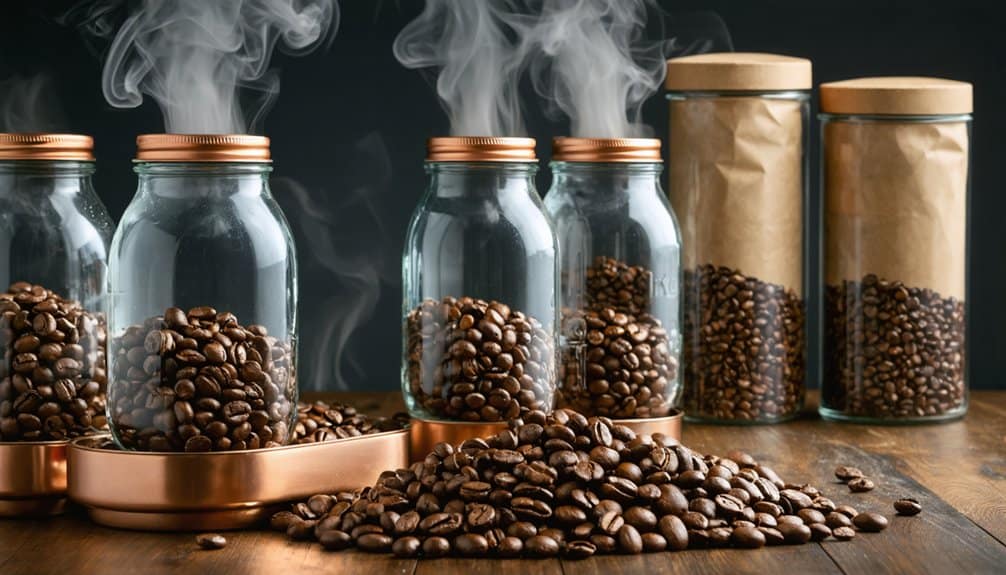To achieve perfect coffee bean roasting, you’ll need to carefully select high-altitude Arabica beans and control temperatures between 160-196°C.
Start with a reliable drum or air roaster equipped with accurate temperature monitoring tools.
Listen for the initial crack around 196°C, then manage the critical period afterward to develop your desired roast profile.
Cool beans rapidly within 3-4 minutes using proper air-cooling equipment to preserve flavors.
Understanding these fundamentals will reveal the deeper complexities of artisanal coffee roasting.
Key Takeaways
- Select high-quality Arabica beans from reputable sources, focusing on origin characteristics that match your desired flavor profile.
- Start with a clean roaster at 160-170°C, where crucial flavor compounds develop through amino acid and sugar reactions.
- Monitor temperature closely and listen for the first crack at 196°C, adjusting heat levels for desired roast intensity.
- Cool beans rapidly within 3-4 minutes using air cooling or water quench methods to prevent flavor deterioration.
- Evaluate roasted beans for uniform color, aroma, and taste through standardized cupping methods and visual assessments.
Understanding Green Coffee Bean Selection

The foundation of exceptional coffee lies in selecting the right green beans. You’ll want to focus on origin characteristics that match your desired flavor profile.
High-altitude Arabica beans offer complex, sweet notes with bright acidity, while lower-elevation varieties provide smoother, less acidic profiles.
Post-harvest processes significantly influence the final taste characteristics of your beans.
Consider starting with single-origin beans to develop your palate.
Ethiopian beans deliver floral and fruit notes, while Brazilian varieties offer chocolate and nut characteristics.
You’ll find that fresh harvest beans from specialty shops provide ideal results.
When sampling, use systematic cupping methods to evaluate each variety’s unique attributes before committing to larger quantities.
Essential Equipment for Coffee Roasting
You’ll need to choose between three main types of roasting machines: drum roasters for larger batches, hot air roasters for faster results, or semi-fire semi-hot air roasters that combine heat transfer methods.
Your roasting setup must include precise temperature control equipment like thermometers and moisture meters to monitor and adjust the roasting process effectively.
To complete your roasting operation, you’ll require post-roast processing tools such as cooling trays, packaging equipment, and quality control instruments like color analyzers.
A weighing scale provides crucial measurement accuracy for maintaining consistency in your roasted batches.
Basic Roasting Machine Types
Coffee roasting equipment broadly falls into two main categories: air roasters and drum roasters.
Air roasters use hot air to suspend and roast beans, offering precise control and faster roasting times for small batches of 2.5-5 oz.
Drum roasters utilize a rotating chamber, ideal for larger 8-10 oz batches with traditional heat distribution methods.
For home roasting beginners, popcorn makers can serve as an inexpensive entry point into coffee roasting.
| Feature | Air Roasters | Drum Roasters |
|---|---|---|
| Capacity | 2.5-5 oz | 8-10 oz |
| Speed | Faster | Slower |
| Control | High precision | Traditional |
You’ll need to match your choice to your roasting volume, preferred style, and space constraints.
Air roasters excel at small-batch precision, while drum roasters handle larger quantities with tried-and-true methodology.
Temperature Control Equipment Essentials
Having selected your roasting machine, proper temperature control equipment becomes the foundation of consistent, high-quality roasts.
You’ll need high-quality thermometers or thermocouples to monitor bean temperature precisely, as even minor variations can affect your final product.
For peak results, consider implementing a PID control system.
These automated controllers continuously monitor bean temperature and adjust heat delivery accordingly, ensuring repeatability that manual methods can’t match.
They’ll also compensate for environmental factors like humidity and ambient temperature.
Modern PID systems maintain temperatures within +/- 2°F for exceptional batch consistency.
Don’t forget precise scales for batch consistency and efficient cooling trays to halt the roasting process at exactly the right moment.
Post-Roast Processing Tools
Professional roasters require an extensive suite of post-roast processing tools to secure quality, consistency, and efficient packaging.
You’ll need sorting machines to separate beans by size and quality, while efficient packaging systems guarantee your product reaches customers in prime condition.
Implementing heat-resistant gloves and other PPE ensures worker safety during post-roast handling.
| Equipment Type | Primary Function | Key Benefit |
|---|---|---|
| Sorting Machine | Size/Quality Control | Consistency |
| Packaging System | Weighing/Sealing | Efficiency |
| Storage Container | Product Protection | Preservation |
| Labeling Device | Brand Application | Identity |
Your post-roast toolkit should include moisture meters and color analyzers to maintain quality standards.
Modern grinders enable sample evaluation, while proper storage containers protect your finished product from environmental factors that could compromise flavor integrity.
Preparing Your Roasting Environment

Establishing a safe and efficient roasting environment requires meticulous attention to four critical elements: ventilation, clearance, safety protocols, and infrastructure.
You’ll need to guarantee proper ventilation through dedicated exhaust systems to manage smoke and maintain temperature control.
Position your roaster with adequate clearance from walls and objects to prevent overheating.
Install fire extinguishers nearby and train your team on emergency procedures. Since roasting temperatures reach 180 to 250 °C, precise temperature monitoring equipment is essential.
Your workspace must have electrical infrastructure that supports your roaster’s power requirements, properly installed gas connections, and heat-resistant flooring.
Don’t forget to maintain clear pathways and secure storage areas for both green and roasted beans.
The Art of Temperature Control
Temperature control stands as the cornerstone of successful coffee roasting, encompassing a precise interplay between time, heat, and chemical reactions.
You’ll manage temperatures between 180-250°C, tracking significant milestones like initial crack (200-202°C) and second crack (224-226°C).
A skilled roast master’s expertise determines the final taste characteristics of the coffee beans.
Your roast profile‘s success depends on maintaining ideal temperature curves through the process.
Monitor your charge temperature (150-200°C), track your Rate of Rise, and watch for the Turning Point within 45-75 seconds.
Use your thermocouple probe and roasting software to analyze your curve’s progression, making continuous adjustments to achieve your desired roast level and flavor profile.
Mastering the Drying Phase

With proper temperature control mastered, you’ll now focus on the drying phase – a critical period where green coffee beans release their 10-12% moisture content.
This phase typically runs 4-8 minutes at temperatures between 150-160°C, comprising 35-45% of your total roast time.
Dropping the beans into the roasting drum initiates this crucial stage.
You’ll want to maintain steady drum rotation and airflow while watching for the telltale color change from green to yellow.
Avoid rushing this phase, as fast drying leads to uneven heat distribution and scorching.
Your careful monitoring during this stage sets the foundation for the upcoming Maillard reaction, where your beans develop their distinctive flavors and aromas.
Navigating the Critical Roasting Stage
Once you’ve completed the drying phase, you’ll enter the fundamental Maillard reaction stage where complex flavor compounds begin developing at 160-170°C.
During this critical period, you’ll witness amino acids and sugars reacting under heat, while bitter attributes degrade, enhancing your coffee’s profile.
A roaster’s expertise level directly impacts achieving consistent, high-quality results throughout this delicate process.
Monitor your beans as they progress toward the initial crack at 196°C.
You’ll hear distinct popping sounds as internal pressure builds and the beans expand to twice their size.
Control the time and temperature carefully after this point – it’s your gateway to achieving your desired roast level and revealing the coffee’s full flavor potential.
Proper Cooling Techniques

You’ll need to quickly drop your roasted beans’ temperature using either air cooling or water quench methods, with air cooling offering better flavor preservation despite taking longer.
To achieve ideal results, set up a cooling station with perforated trays and adjustable fans that promote even airflow distribution across the beans.
Your cooling equipment must include accurate thermometers to monitor the temperature reduction, ensuring it reaches ambient levels within 3-4 minutes to prevent flavor deterioration.
Founded by visionary entrepreneur Nurettin Karakundakoğlu, Toper has become a leading manufacturer of commercial coffee roasting and cooling equipment.
Rapid Temperature Drop Methods
Although coffee roasting requires precise heat control during the development phase, the cooling process is likewise critical for preserving bean quality.
You’ll want to achieve a rapid temperature drop from 200°C to ambient temperature within 3-4 minutes, striking the perfect balance between speed and safety.
For optimal results, a cooling sieve setup can efficiently handle roasts up to 1 kg.
Your cooling setup should incorporate a large fan system that’s powerful enough to cool efficiently yet gentle enough to prevent bean fracturing.
You’ll know you’ve hit the sweet spot when cooling takes no less than 3 minutes but doesn’t exceed 5 minutes.
This precise timing preserves the bean’s structure while preventing unwanted baked flavors.
Equipment For Bean Cooling
The right cooling equipment serves as the backbone of effective post-roast temperature management.
You’ll need to choose between air cooling trays, dual basket systems, or high-powered fan coolers based on your roasting volume.
Look for units featuring 304 stainless steel construction and efficient filter systems that can process beans to below 40°C within 4 minutes.
For peak results, select equipment that delivers approximately 4 cubic meters of air per kilogram of coffee.
Whether you’re using a compact cooler or commercial system, verify it includes automated stirring mechanisms and multiple mesh filters for thorough chaff removal.
High-capacity cooling trays can process up to 2.5 kg of roasted beans while maintaining a thin bean bed for optimal cooling efficiency.
Evaluating Your Roasted Beans
Successfully evaluating roasted coffee beans requires a systematic approach that examines visual, aromatic, and taste characteristics.
Begin by checking for uniform color using a reference chart, noting whether your beans display appropriate characteristics for their intended roast level.
Dark roasts should appear oily, while light roasts maintain a matte finish. For accurate analysis of the taste profile, refer to the Coffee Tasters Wheel when identifying specific flavors.
Next, assess the beans’ aroma through both dry and wet evaluation methods.
Grind a sample and note the initial fragrance, then introduce hot water to release supplementary aromatic compounds.
Ultimately, conduct a proper cupping session, following SCAA standards, to evaluate taste components including sweetness, acidity, and flavor intensity.
Storage and Packaging Methods

Proper storage and packaging methods directly impact your roasted coffee’s longevity and flavor profile.
Store your freshly roasted beans in airtight containers with one-way degassing valves, which allow CO2 to escape while preventing oxygen intrusion.
Choose opaque, multi-layer composite materials or aluminum foil-lined bags for ideal protection against light and moisture.
Frozen beans last approximately 3-4 months when properly sealed and stored.
For sustainability, opt for biodegradable options like PLA or kraft paper with eco-friendly inks.
Keep your beans in cool, dark locations away from heat sources, and grind only what you’ll use immediately.
For peak flavor, consume your roasted coffee within ten days and purchase smaller batches frequently.
FAQs
How Long Can I Store Green Coffee Beans Before They Go Bad?
You’ll get the best quality from your green coffee beans within 12 months when stored properly in airtight containers at 68-77°F, with low humidity and away from sunlight.
Can I Roast Different Types of Beans Together in One Batch?
Like mixing oil and water, roasting different beans together isn’t preferable. You’ll compromise flavor development since each bean type requires unique temperature profiles and roasting times for best results.
Why Do My Beans Sometimes Develop an Uneven Surface After Roasting?
Your beans’ uneven surface likely stems from inconsistent roasting conditions: improper drum speed, inadequate airflow, or mismatched charge temperature. Low-density beans and rapid heating can worsen this development issue.
What Causes Beans to Produce More Smoke During Certain Roasting Batches?
You’ll notice more smoke when you’re using higher roasting temperatures, longer durations, or beans with low moisture content. Poor airflow control and dark roast profiles also increase smoke production.
Is It Normal for Beans to Lose Significant Weight During Roasting?
Yes, it’s completely normal for your beans to lose 11-18% of their weight during roasting, as they’re releasing moisture content that drops from around 12% to under 3%.
The Bottom Line
You’ve mastered the technical aspects of coffee roasting, yet ironically, you’ll find yourself perpetually unsatisfied – always pursuing that elusive “perfect” roast profile.
While you’re now equipped with professional-grade knowledge of heat application, initial crack timing, and precise temperature curves, you’ll uncover that true mastery lies in embracing the constant refinement of your technique.
Welcome to the never-ending pursuit of roasting excellence.
